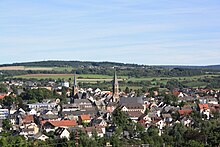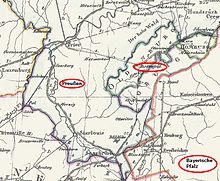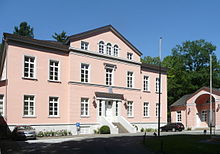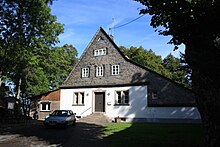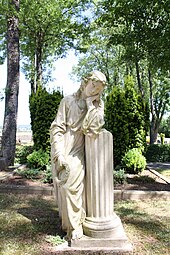Birkenfeld (Nahe)
| coat of arms | Germany map | |
|---|---|---|

|
Coordinates: 49 ° 39 ' N , 7 ° 10' E |
|
| Basic data | ||
| State : | Rhineland-Palatinate | |
| County : | Birch field | |
| Association municipality : | Birch field | |
| Height : | 397 m above sea level NHN | |
| Area : | 13.58 km 2 | |
| Residents: | 7016 (Dec. 31, 2019) | |
| Population density : | 517 inhabitants per km 2 | |
| Postal code : | 55765 | |
| Area code : | 06782 | |
| License plate : | BIR | |
| Community key : | 07 1 34 010 | |
| Association administration address: | Schneewiesenstrasse 21 55765 Birkenfeld |
|
| Website : | ||
| City Mayor : | Miroslaw Kowalski ( CDU ) | |
| Location of the city of Birkenfeld in the Birkenfeld district | ||

Birkenfeld is a town in the Birkenfeld district in the southwestern part of Rhineland-Palatinate . It is the seat of the district administration, a state-approved resort and according to state planning as a middle center.
geography
Birkenfeld is located in the Nahe area - north of the river - on the edge of the Saar-Hunsrück nature park . Adjacent communities are - clockwise, starting in the north - Gollenberg , Elchweiler , Schmißberg , Rimsberg , Dienstweiler , Ellweiler , Dambach , Brücken , Buhlenberg and Ellenberg .
history
The name Birkenfeld is of Franconian origin and means something like "near the field with the birches ". From this it can be concluded that the present-day settlement was founded by Franconian-German farmers in a striking location with a dense birch population. To this day there is a high population of birch trees in the bird sanctuary by the clay pits.
The name Birkenfeld was originally "Bikenuelt" (around the year 700) or "Birkinvelt" when the Trier Bishop Egbert was mentioned in a document in 981. This document shows that Saint Liutwin (695–713 Archbishop of Trier) took over the churches zu Birkenfeld and Brombach had given the monastery St. Paulin in Trier.
Finds from the Iron Age, however, indicate a dense settlement as early as the 8th century BC. Chr. In the 1st century BC Roman legions conquered this area, which remained under Roman rule for 400 years . This is proven above all by finds in the immediate vicinity of the city. Today's Birkenfeld is located directly on a Roman road that served as a cross connection between two important military roads, namely the Trier-Bingen-Mainz road in the north (this was mentioned in the year 350 in the Mosella by the Roman poet Ausonius and in some parts corresponds to today's Hunsrück-Höhenstraße) and in the south the street Metz-Mainz. This cross-connection, also known as "Bronzestraße", connected Glan-Nohen-Mosel with one another. The Bronzestraße crossed the Nahe in Nohen ("villa Aldena") and continued to run directly through the Wasserschieder Wald, a state forest that still exists today on the outskirts of Birkenfeld, via Gollenberg past Börfink towards Trier.
The Franconian settlement "Birkinvelt" belonged to the Counts of Sponheim in the 13th century. In 1223 the county of Sponheim was divided, and Birkenfeld came to the rear county of Sponheim in the possession of the counts on the Starkenburg near Trarbach . Birkenfeld Castle was first mentioned in 1293 . In 1332 Birkenfeld was granted city rights by Emperor Ludwig the Bavarian .
After the death of the last Count of Sponheim in 1437, the inheritance, the Hintere Grafschaft, passed to the Margraves of Baden and the Counts of Veldenz . In 1584, a branch of the Wittelsbach family , the Count Palatine Karl von Pfalz-Zweibrücken-Birkenfeld , resided in this place. In that year, work began on expanding the castle into a princely palace in the Renaissance style. Exactly 140 years later, the last remnants of the royal court at Birkenfeld Castle were dissolved. During the Thirty Years' War (1618–1648), the city was an immediate theater of war in 1635. In the same year the plague broke out in Birkenfeld and claimed 416 lives.
In 1776, under Margrave Karl Friedrich , Birkenfeld became the seat of the Upper Office of the Margraviate of Baden. During this time Birkenfeld flourished. The place experienced an economic and cultural boom. In 1779, for example, the first “secondary school” was founded.
After taking the left bank of the Rhine by French revolutionary troops , the region in 1797 was supported by France annexed . From 1798 to 1814 Birkenfeld was the capital of the canton of the same name in the Saar department .
After the Congress of Vienna (1815) the area of the later Principality of Birkenfeld came to the Grand Duchy of Oldenburg in 1817 . Under the Oldenburg rule, the new castle, which is now the seat of the district administration, was built in 1821. Not only the new castle, but also other buildings in the government district, such as the infantry barracks (building of the grammar school until 1963, today Office for Defense Burdens) characterize the Birkenfeld cityscape in the classicistic style of the Oldenburg period.
In the Third Reich , the place became part of the Prussian district of Birkenfeld on April 1, 1937 , which was formed from the former Oldenburg areas and the remaining district of Sankt Wendel-Baumholder . After the Second World War, Birkenfeld belonged to the French occupation zone and has been a district town in Rhineland-Palatinate since 1946.
Birkenfeld was an important military base for the Americans until 2014 and then for the Bundeswehr . The 2nd Air Force Division had its headquarters in the Heinrich Hertz barracks. In connection with the Börfink command bunker , Birkenfeld was an important NATO location until 2002 . During the refugee crisis in Europe in 2015 , 1,100 refugees were accommodated in the Heinrich Hertz barracks.
Historical
In February 1797, the robber Johannes Bückler , who became known as Schinderhannes , broke into the cloth factory of the Stumm brothers - the later coal and steel entrepreneurs on the Saar. Most of the cloth stolen during this break-in was sold by the Schinderhannes to a fence in Hundheim near the Stumpfen Turm .
Population development
The development of the population of Birkenfeld, the values from 1871 to 1987 are based on censuses:
|
|
Graphic of the population development |
religion
On October 31, 2014, 46.69 percent of the population were Protestant and 29.745 percent Catholic. In addition to the two large parishes - Evangelical Church Congregation Birkenfeld and Catholic Church Congregation St. Jakobus Birkenfeld - there is an Evangelical Free Church Congregation ( Baptists ), a Mennonite Brethren Congregation , a New Apostolic Church and Jehovah's Witnesses .
politics
Birkenfeld has been a district town since 1947 and forms an association municipality with 30 other municipalities - the Verbandsgemeinde Birkenfeld .
In October 2010, the city received the title “ Place of Diversity ” awarded by the federal government .
City council
The city council in Birkenfeld consists of 22 council members, who were elected in a personalized proportional representation in the local elections on May 26, 2019 , and the honorary city mayor as chairman.
The distribution of seats in the city council:
| choice | SPD | CDU | FDP | BFL | BfB | total |
|---|---|---|---|---|---|---|
| 2019 | 7th | 11 | - | 4th | - | 22 seats |
| 2014 | 9 | 9 | 1 | 2 | 1 | 22 seats |
| 2009 | 8th | 8th | 1 | 2 | 3 | 22 seats |
| 2004 | 8th | 11 | 1 | 2 | - | 22 seats |
- The BFL is the Birkenfelder Freie Liste eV
- The BfB are the citizens of Birkenfeld eV
mayor
Peter Nauert is the first mayor who was elected in a primary election of the Birkenfeld citizens. His two predecessors, Manfred Dreier and Erich Mörsdorf, headed both the city and the community of Birkenfeld in personal union.
Werner Buyer was the last full-time mayor of the city of Birkenfeld. Although he was confirmed in office for a further 12 years by a large majority in 1968, he had to give up his full-time office as city mayor as early as 1970 due to the Rhineland-Palatinate municipal reform, in which cities with less than 7,500 inhabitants were incorporated into association municipalities .
- Eugen Ruppenthal from 1923 to 1933 and from 1949 to 1953
- Oswald Morenz from 1953 to 1961
- Werner Buyer from 1961 to 1970
- Erich Mörsdorf from 1971 to 1990
- Manfred Dreier from 1990 to 2000, (SPD)
- Peter Nauert from 2000 to 2014, (CDU)
- Miroslaw Kowalski since 2014, (CDU)
coat of arms
The city coat of arms, which was approved by the Ministry of the Interior in Oldenburg on October 29, 1923, comes from an old court seal from 1577. It shows a natural-colored tree with roots on a green hill on a blue background. Part of the trunk is covered with a red and silver nested shield. The tree, which represents a birch, indicates the place name. The applied shield is reminiscent of the coat of arms of the Hinteren Grafschaft Sponheim , to which the city once belonged.
Town twinning
To the French city of Audun-le-Tiche in the Moselle department is one since 2010 twinning .
Culture and sights
Lambda dialect in local dialect
In earlier times, the local Birkenfeld dialect had a specialty: It often replaced the sounds / d / and / t / with / l / ( lambda dialect ); the same was true for the sound / r /. Word example: “Fulerlale” for “food shop”, or, as a sentence example, the Birkenfeld sexton “Fuchs Karl” to the church councilor and pastor Haag: “ Jo, jo, Mr. Kirjerot, pririje kann e jela, awa long net loule! “(Yes, yes, Mr. Church Council, everyone can preach, but by no means ring the bell!).
However, Lambdazism has now completely disappeared from the Birkenfeld dialect and has instead given way to the Rhotazism common in the Hunsrück dialect .
Museums
The state museum of the local history association in the district of Birkenfeld offers an overview of 2500 years of cultural history . The focus is on the interactive Celtic experience exhibition “Experience the Celts, Art and Cult”. There, the visitor is introduced to the life and craft of these by means of reconstructions and archaeological finds and replicas . In addition, a large part of the exhibition deals with the regional and territorial history of the Birkenfelder Land. In this context, historical highlights are the High Middle Ages (13th to 15th centuries) and, from the early 20th century, the Oldenburg period of the Principality of Birkenfeld. Regularly changing exhibitions deal with historical and current topics.
Maler-Zang House
The Maler-Zang-Haus is located directly next to the Landesmuseum Birkenfeld. The house, built in the bourgeois-classicist style in 1883, is the former home of the painter Hugo Zang (1858–1946). In 2006, work began on restoring the house in accordance with a listed building. Since 2008, the building has housed the Birkenfeld district adult education center and seven gallery rooms for changing exhibitions of regional and national artists. The district administration announced in 2016 that it wanted to close the house and in future only use the premises as the district's office space.
Buildings
Historic buildings in Birkenfeld are the Birkenfeld castle ruins , the Birkenfeld Castle , the former Oldenburg barracks and the old town house . The castle Birkenfeld was once the residence of the Wittelsbach line of Pfalz-Birkenfeld. The castle was the residential palace of the Grand Duke of Oldenburg.
Cultural and natural monuments
Leisure and Tourism
In addition to the historically significant buildings in the city, the Birkenfeld State Museum and the Maler-Zang-Haus, the landscape of the low mountain range between Hunsrück and Nahe offers opportunities for activity and relaxation.
Hiking trails
The Nahehöhenweg , which runs nationwide, touches the city of Birkenfeld. The Sironaweg , which led along a large number of Celtic-Roman finds, is no longer signposted as a continuous hiking trail. However, the individual stations can be visited. With the Nohener Nahe loop premium hiking trail, one of the 111 dream loops of the Saar-Hunsrück-Steige runs around five kilometers from Birkenfeld along the Nahe.
Bike lanes
The 120-kilometer Nahe cycle path and the Rhineland-Palatinate route run directly through the center of the city. They are supplemented by three local circular bike tours, R1, R2 and R3 with a total length of almost 80 kilometers.
Economy and Infrastructure
economy
The city's economy is mainly characterized by small and medium-sized businesses. Due to its history as a residential and administrative city, no major industrial development took place in Birkenfeld.
The Elisabeth Foundation of the German Red Cross (DRK) is the largest employer with the hospital, the Birkenfeld professional development agency , private technical schools, measures for young people and a retirement home with over 600 employees.
The Stefan Morsch Foundation is also based in Birkenfeld.
A business start -up center (BIG Center) was built on the site of the former train station in the 1990s .
traffic
- Road network
Birkenfeld is well connected to the trunk road network by the federal roads 41 (east-west connection: Mainz to Saarbrücken ) and 269 ( Bernkastel-Kues to Saarlouis ), as well as the Autobahn 62 . This motorway is also the most important north-south connection and provides the connection to Trier and Kaiserslautern .
Furthermore, the Hunsrückhöhenstraße ( B 327 ) and thus Hahn Airport can be reached quickly via the B 269 (50 km).
Birkenfeld is served by the Regio-Route 330 Idar-Oberstein - Oberbrombach - Birkenfeld Talweiherplatz every hour, on weekends every two hours.
- Rail network
Birkenfeld is connected to the Nahe Valley Railway from Saarbrücken to Frankfurt am Main through the Neubrücke train station, which is five kilometers away . You can be in Saarbrücken in 45 minutes and Frankfurt in less than two hours.
The end track ( Birkenfeld Railway ) that used to lead to Birkenfeld was closed and is now a cycle path.
Public facilities
Educational institutions
Since 1996, a university of applied sciences has been established on the site of a former US military hospital in the neighboring community of Hoppstädten-Weiersbach . The Environmental Campus Birkenfeld carries, as the site of the University of Trier , strengthened the economic development of the region Birkenfeld at.
There is a wide range of options for school-age children. The primary school as well as the regional school since 2003 also as an all-day school .
- primary school
- Realschule plus
- Birkenfeld high school
- Special school with a focus on learning
The Elisabeth Foundation is of supraregional importance with specific qualification offers for people with (physical and mental) disabilities as well as private technical schools. The graduates come from all over Germany and neighboring countries.
Other offers include a. the adult education center (VHS) for the Birkenfeld district.
Authorities
Birkenfeld is the location of the following authorities:
- District administration
- Association municipality administration
- Federal agency for work
- Land registry
- Police inspection
- Forestry Office
- National Park Office Hunsrück-Hochwald
Leisure and sports facilities
At leisure and sports facilities there are u. a. a heated outdoor pool , the stadium on the mountain , several sports halls, an animal park , two libraries , a specialist library and the youth center. In 2000, a skate facility was built at the youth center, which was expanded in 2005 to a fun box, a quarter, a ramp and an obstacle.
people
sons and daughters of the town
- Elisabeth von der Pfalz (1540–1594), second wife of Duke Johann Friedrich II. Of Saxony
- Karl II. Otto (1625–1671), Duke and Count Palatine of Birkenfeld
- Ludwig von Liebenstein (1781–1824), member of the Baden state parliament
- Carl Ludwig Frommel (1789–1863), painter, etcher, copper and steel engraver
- August Barnstedt (1823–1914), District President of the Principality of Birkenfeld
- Emil Volkers (1831–1905), horse painter
- Christian Warth (1836–1890), modeller and draftsman (known for the series- produced figure "Mourner" by Villeroy & Boch , which can be found in numerous cemeteries)
- Julius Upmann (1838–1900), chemist, explosives expert
- Julius von Wedderkop (1849–1921), officer and court official
- Alfred Eppler (1867–1923), mineralogist
- Otto Pick (1882–1945), DDP member of the Reichstag
- Gustav Behrens (1884–1955), historian and museum director
- August Rippel-Baldes (1888–1970), founder of microbiology
- Edmunda Klein (1898–1995), Superior General of the Waldbreitbach Franciscan Sisters
- Julius Pauly (1901–1988), lawyer and politician (NSDAP)
- Eugenia von Skene (1906–?), Kapo in the Ravensbrück concentration camp
- Walter Bleicker (1909–2000), honorary citizen, Managing Director of the Elisabeth Foundation from 1966 to 1980
- Gerd Menne (1939–2020), soccer player and coach
- Heiner Flassbeck (* 1950), economist, former State Secretary D., former chief economist at UNCTAD
- Hans-Werner Wahl (* 1954), psychologist and aging researcher
- Joachim Theis (* 1955), Roman Catholic theologian
- Frank Palm (* 1962), professor of oral and maxillofacial surgery
- Ulrich von Plettenberg (* 1964), Roman Catholic priest and vicar general in the Trier diocese
- Heike Abidi (* 1965), copywriter and author, who also writes under the pseudonyms Emma Conrad, Jana Fuchs and Maya Seidensticker
- Jörn Leonhard (* 1967), historian and university professor
- Lorielle London (born 1983), entertainer
- Matthias Henn (* 1985), soccer player
Other people
- Ludwig Friedrich Schmidt (1764–1857), pastor in Birkenfeld, later cabinet preacher to Queen Karoline of Bavaria and first Protestant pastor in Munich, is considered the father of the Evangelical Church in Bavaria .
Numerous personalities went to school in Birkenfeld:
- Friedrich Back (art historian) (1860–1932), art historian and museum director in Darmstadt
- John Henry Mackay (1864–1933), Scottish-German writer
- Friedrich Cassebohm (1872–1951), lawyer and politician, a. a. Prime Minister of the Free State of Oldenburg
- Reinhard Goering (1887–1936), writer, Kleist Prize (1930)
- Gerhard Storm (1888–1942 in Dachau concentration camp) is a martyr of the Catholic Church
- Paul Brenner (politician) (1905–1988), member of the state parliament (CDU) and first member of Birkenfeld
- Klaus Rüter (* 1940), lawyer, administrative officer and politician (SPD).
- Nicole (* 1964), singer, winner of the Eurovision Song Contest with " A little peace "
literature
- Heinrich Brucker: Birkenfelder Land memories . Geiger-Verlag, 1990, Birkenfeld
- Kurt Hartong: The Birkenfeld "Revolution" of the summer of 1919 . In: Oldenburg Yearbook . Vol. 78/79 (1978/79). Pp. 83–130 ( online )
- Franz-Josef Heyen / Theresia Zimmer: Book of arms of the Birkenfeld district , published by the Birkenfeld district and the Rhineland-Palatinate State Archives Administration, Volume 6, self-published by the Rhineland-Palatinate State Archives Administration, 1966, Koblenz
- Hugo Klar: Essays on local history in the Birkenfeld district . Volume II, special issue 24, ed. Association for local history in the Birkenfeld district, 1974, Birkenfeld
- Alexander Thon, Stefan Ulrich u. Achim Wendt: "... where a mighty tower defiantly looks down". Castles in the Hunsrück and on the Nahe . Regensburg: Schnell & Steiner 2013, ISBN 978-3-7954-2493-0 , pp. 32–35 (on Birkenfeld Castle).
Web links
- Official website of the city of Birkenfeld
- Link catalog on the topic of Birkenfeld at curlie.org (formerly DMOZ )
- Literature about Birkenfeld in the Rhineland-Palatinate State Bibliography
Individual evidence
- ↑ a b State Statistical Office of Rhineland-Palatinate - population status 2019, districts, municipalities, association communities ( help on this ).
- ↑ a b State Statistical Office Rhineland-Palatinate - regional data
- ↑ http://www.swr.de/landesschau-aktuell/rp/trier/aufregung-in-oberhambach-protest-gegen-fluechtlinge-in-ferienpark/-/id=1672/did=16296478/nid=1672/dj9n3m /index.html
- ↑ Peter Bayerlein: Schinderhannes Ortlexikon. Mainz-Kostheim 2003, p. 38.
- ↑ Municipal statistics . In: KommWis. October 31, 2014, accessed November 30, 2014 .
- ^ The Regional Returning Officer Rhineland-Palatinate: Local elections 2019, city and municipal council elections
- ↑ http://www.swr.de/landesschau-aktuell/rp/trier/maler-zang-haus-in-birkenfeld-verbindungsplaene-sorgen-fuer-aerger/-/id=1672/did=17331506/nid=1672 /a2fq3b/index.html
- ^ Category at Wikimedia Commons



